The thing that originally sparked my interest in chimpanzees was the fact that they could learn sign language. Ape language studies of the ’60s and ’70s not only helped bridge the gap between the complex languages of humans and the seemingly much simpler grunts, barks, and chirps of other animals, but they hinted at a possibility almost too magical to believe: could signing chimpanzees actually tell us what they were thinking?
They could, and they did. Many of us at CSNW were lucky enough to help care for some of these signing chimpanzees during their later years and to converse with them in the process. And never have I been as humbled as I was on my first day of training, when I realized that the chimps signed faster and with a greater vocabulary than I could understand. This was a good way to put a new graduate student in his place.
As amazing as that experience was, however, we ultimately learned an even greater lesson from our mentors: Animals don’t need to learn our language to tell us what they are thinking. We can learn theirs.
Spend enough time around chimps and you start to absorb their mannerisms. You bob your head during greetings and crouch down low when placating a dominant chimp. You extend an arm when you need help and stomp your foot on the ground when initiating a game of chase. You pick up on the subtleties of their facial expressions, covering your top teeth when you smile and pouting your lips in sympathy when someone is upset. And if you’re not too self-conscious, you start to sing along when they pant hoot in excitement, or join in breathy laughter when tickling them with a stick.
Training as a caregiver at CSNW means training in chimp language, because the chimps never stop communicating their thoughts and desires. From the moment we walk in the door in the morning, they are telling us what’s on their minds. For Jamie, it’s all about boots. She can’t wait for her caregivers to don a pair of her favorite cowboy boots and chase her around the chimp house. She tells us what she wants by gazing and pointing toward the boot bin while stomping her feet. She has a mental catalogue of all the boots in her collection and knows which pair she wants, and if we draw up the wrong pair she shakes her head and tells us to try again.
It’s easy to figure out what Jamie wants, though, because she’s so predictable. The same is true for Negra, who claps to prod her caregivers into action at least 30 minutes before each mealtime. Other situations require more thought. Sometimes Burrito greets us exuberantly first thing in the morning and initiates a game of chase. We chase after him for a while until he stops suddenly and begins to blow raspberries while pointing at something just outside the enclosure. Our eyes scan the ground until we finally come across the real reason for his excitement: a piece of food left over from the previous night’s dinner, just out of reach. Missy does something similar, except that her games of chase always end at the window facing the garden, where ripe cherry tomatoes grow just a few feet away. Her hand points towards the garden while her gaze switches back and forth between our eyes and the tomatoes, drawing an imaginary line between the two. The phrase “ulterior motive” had to have been coined by someone who worked with chimpanzees.
Throughout the day we hear updates from the chimps from afar. When a threat bark pierces the silence of an afternoon meal, it means that one of the caregivers has unwittingly violated the chimps’ social order, perhaps by serving food to a low ranking chimpanzee out of turn. Alarm calls can be easily differentiated into degrees of severity – single “hoo” calls mean that one chimp has seen something they can’t quite make sense of, while multiple “waa” calls mean that the group has identified and rallied around a source of danger. Even the “waa” calls can be broken into different levels of intensity, telling you whether they have uncovered a small garter snake or a large, and potentially deadly, rattlesnake.
Closing up at night involves a routine that might sound familiar to anyone with young kids, but instead of “can you read me just one more story” or “can I have a glass of water”, it’s “can you give me just one more troll doll” or “can I have the boots you walked in this morning.” This process of making sure the chimps have everything they want before they go to bed can last for the better part of an hour, depending on their moods, and sometimes involves dumping everything out of the toy bins so that they can pick out exactly what they want. But when you figure out what they want, whether it’s that black pair of boots with the white stitching or the new Dora the Explorer doll, they often let you know with a low moan, while clutching the item gently to their chest. Reminiscent of Chewbacca, the low moan indicates satisfaction, and tells us all is good.
We talk to each other like this all day long and at the end of the day, the only thing left to say is “goodnight”, which in chimp-speak is delivered as a series of soft grunts, pants, and hoo’s known collectively as nest grunts. We caregivers often initiate this as we lock up for the night, and the chimps respond in turn. It’s a subtle and beautiful chorus; a vocalization that began high up in the trees of central Africa but somehow echoes from cozy blanket nests in a small sanctuary in Cle Elum.
It says, “we are all safe now, see you tomorrow,” in a language all their own.
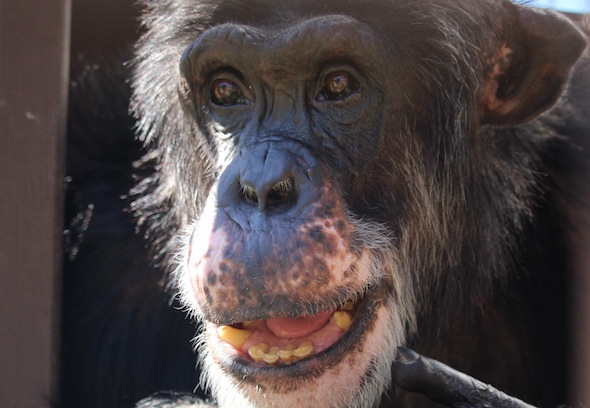
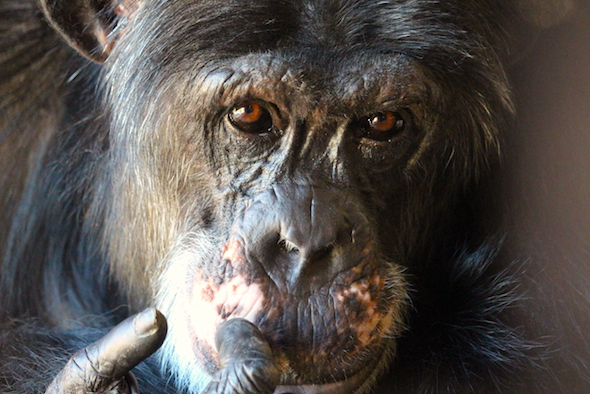
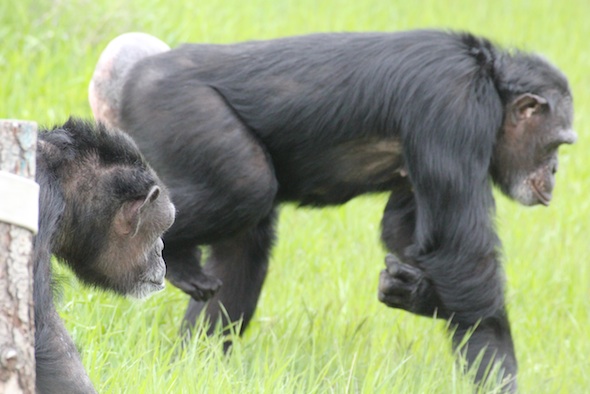
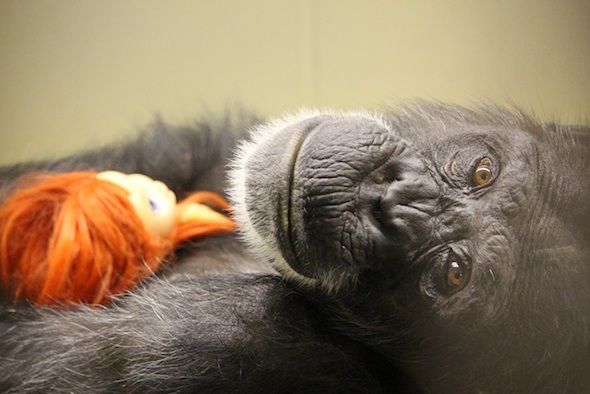
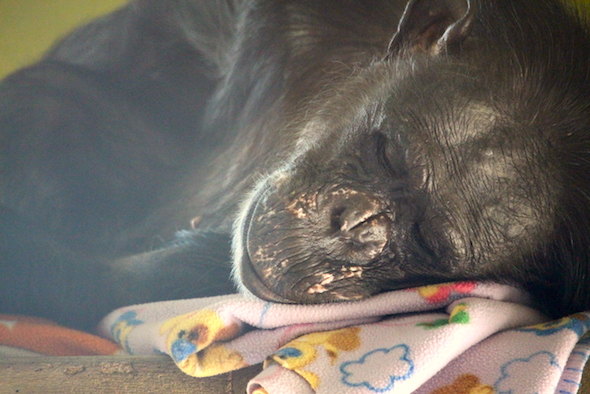





Wonderful blog!
Thank you J.B.
Fabulous entry….thank you, J.B.!!
Loved this blog. It touched my heart. Thank you.
Beautiful…
Lovely. Thank you
Wonderful post!
What a fantastic post – I love all the pictures, especially the last … Asleep and safe – perfect!
I was so disapointed when he didn’t accompany it with a video so we could hear it all, y’knw? 😀
J.B., I am so very impressed. This was just so beautifully and well-written–almost as if reading from one of the classical authors who still knew how to weave language and story elements into a stunning tapestry, so rich in colour you still see it long after you’ve closed your eyes. A story that, when presented to the public for approval, gets so devoured by the reader all they can say is, “Are you freaking kidding me? WHERE’S THE REST OF IT?!”
I know your post is about the chimps, but it is well-done (well, ignoring the oopsie on the ’60s and ’70s typos ;)), and is obviously reaching your readers because you did something most writers don’t do: you wrote from your heart and was more translucent than I’ve seen you. It was amazing, Jeeb. Your portrait of your friends is lovely. I hope you write more.
<3
Srry–just one more question.
So is Keith LaChappelle still involved with this incarnation of the Sanctuary? I don’t see his name on active staff listings or even the BoDs.
And until just a few days ago, I was uaware that other chimps even inhabited this place. I’m reticent to ask what happened to them, in case it was horrible or painful, so apologies in advance if that’s the case, and you don’t have to answer. If it is, then just “grunt” and I’ll get the picture. 🙂
Good catch! We don’t have time for proof-reading when the chimps are waiting for their dinner, so we just post the blog warts and all.
And to clarify, we worked with signing chimps but not at CSNW – all of our staff and many of our volunteers studied at the Chimpanzee and Human Communication Institute prior to or concurrent with out time at CSNW. The Cle Elum Seven are the only chimps who have ever lived here. Keith is still involved with the sanctuary but not as a staff member or board member. He has his own tab under “About Us” on the website.
Okay, cool. Thanks for this clarification.
And no one else notices the warts, cause they’re obviously not the most important part. I just always happen to notice and I can’t help it, so I never mean to offend. My folks said I was reading the dictionary at 4, so it’s like I can’t unsee them.
You guys are so well-trained, intelligent and literate anyway, there are hardly any that makes it through, and I know someone else mentioned that previously. So, it’s all good. 🙂
what a beautiful and educational post. it’s getting crowded in my “bin” of favorite posts. <3
Oh J. B., why do your insightful posts often leave me teary eyed. Like you, I was enthralled with chimpanzees like Nim, Booee, Washoe and her family. They lured me into their clutches. Communicating with a chimpanzee was so captivating to me. And then I read Nim’s story and realized we humans had it ALL wrong. Why do they have to have “our language”? All creatures do an excellent job of communicating on their own, in their own language. Even dogs communicate, we just need to “listen” to what they are saying! We need to watch to hear. What an honor to be able to pant, hoot, grunt, slap, stomp with a chimpanzee! Your education and experiences led have you to a place unimaginable to most. How lucky are you to share day to day delights and greviences with these seven amazing people?! Please write a book about it all some day.????
JB, what a well written, informative piece. I can picture the bedtime routine as if I was there. How lucky you are to be able to communicate and interact with the chimps. Thank you for sharing your thoughts.
JB
Thanks so much for sharing all that information. I like the fact that your crew is learning their language. Nicely written.
Laurie
Thank you J.B. What a wonderful blog. So informative and heartwarming. As much as I would love to visit the sanctuary during the day and see the chimps active and enjoying the outdoors, I think it might be even more special to be there at nighttime when they are requesting their favorite item and saying good night:)
Wonderful, wonderful blog! Thank you for the education and for your beautiful expression of what it is like to work with these chimps, as well as the sign language chimps. For those who want to hear chimp calls, google them and listen to them all day long. It is really remarkable how, at the end of the day, you can recognize the individual calls. They, like us, have their own voices. Thanks again for this remarkable blog! I especially like the bedtime routine.